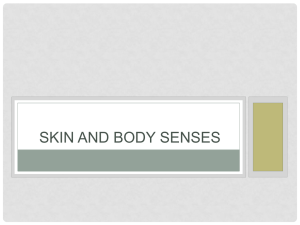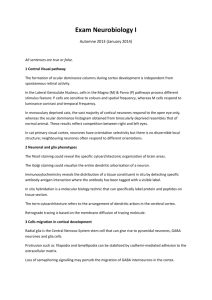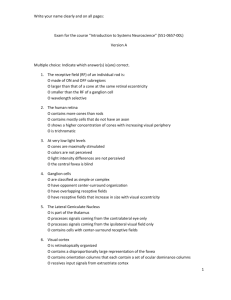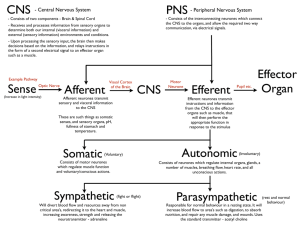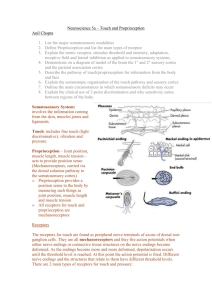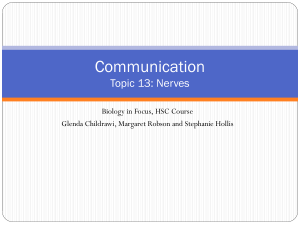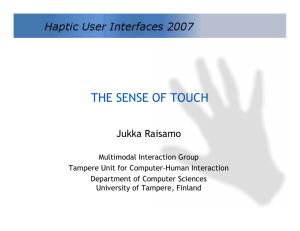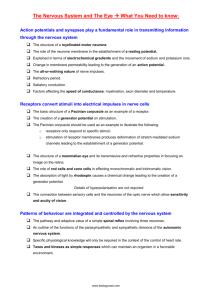The Somatosensory System
advertisement
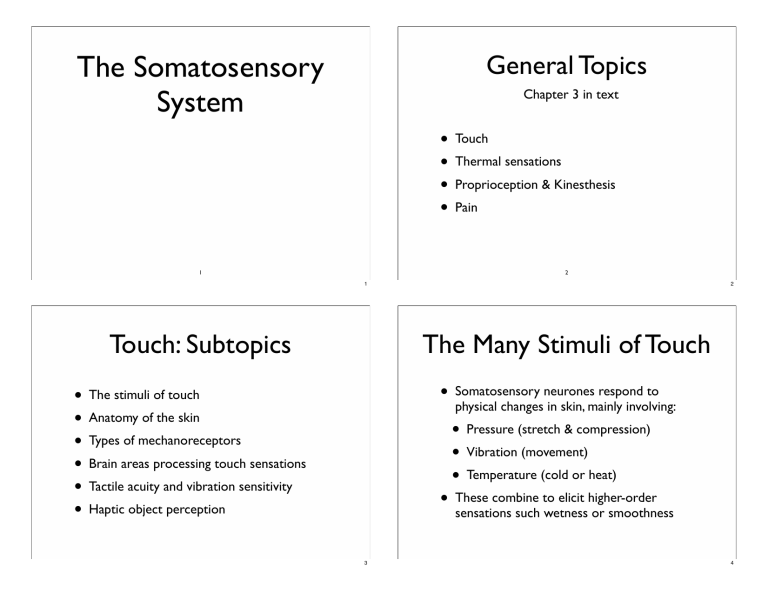
The Somatosensory System General Topics Chapter 3 in text • Touch • Thermal sensations • Proprioception & Kinesthesis • Pain 1 2 1 Touch: Subtopics 2 The Many Stimuli of Touch • Somatosensory neurones respond to • The stimuli of touch • Anatomy of the skin • Types of mechanoreceptors • Brain areas processing touch sensations • Tactile acuity and vibration sensitivity • Haptic object perception physical changes in skin, mainly involving: • Pressure (stretch & compression) • Vibration (movement) • Temperature (cold or heat) • These combine to elicit higher-order sensations such wetness or smoothness 3 4 Pressure • Measured in Pascals (N/m2) or, if area is kept constant (and gravity), can be measured in grams (g) • Pressure thresholds vary depending on many factors, such speed and depth/distance of skin deformation, body location, area of skin affected, etc. Vibration • Variations in skin pressure across time • Frequency of vibration is measured in Hertz (Hz) = cycles/second • Amplitude of vibration measured in meters (usually µm) An Esthesiometer • The basis for the sense of movement across the skin, which is important in (e.g.) tool use 5 6 Temperature Pain • Measured in degrees Celsius (C°) • Decreases or increases from physiological • Excessive intensities of pressure, vibration, and temperature (as well as pH) produce painful sensations. zero (≈32 C°) are detected respectively by cold and warmth thermoreceptors. • The pain threshold varies according to many factors. • Threshold for detection depends on rate of • Pain is in general a very complex and subtle change (C°/s) and area of skin (cm2) affected, among other things. topic. 7 8 Skin & (some) Mechanoreceptors Anatomy of Skin • • • Heaviest and largest sense organ by far Two main layers: • Epidermis: Outer layer, made up mainly of keratinized skin cells • Dermis: Below the epidermis. Contains three categories of mechanoreceptors Two types of skin: Hairy and hairless (no, shaving doesn’t change the type), with different elastic properties. 9 10 9 10 11 12 Mechanoreceptors • Sensory neurones. Signal pressure on skin • Respond to mechanical deformation of the receptor or associated structure • Three main categories: • Encapsulated • Accessory-structure-associated • Free nerve endings Encapsulated Mechanoreceptors • • • Meissner corpuscle • Each of these is a neurone with a specialized ending growing out of its dendrite(s) Mechanoreceptors w/ Accessory Structures Ruffini corpuscle Pacinian corpuscle • Merkel Disc: Dendrites from mechanoreceptor surround a separate skin cell called a Merkel cell • Root Hair Plexus: Dendrites surround follicle • These neurones lack a specialized ending, instead relying on contact with a separate structure. (we will see this idea again in proprioception) 13 14 13 Free Nerve Endings 14 Questions? • Simply neurones with extensions* that terminate close to skin’s surface • No corpuscle or accessory structure • Some are mechanoreceptors, but: • Some respond to heat & cold • What are the three main types of mechanoreceptors? • What are the two main layers of skin? (thermoreceptors) • Others signal various sorts of pain (nociceptors) * FNE “extensions” are not (strictly speaking) dendrites, for reasons we’ll get into later... 15 16 From Skin to Spine DRG Neurones • When appropriately stimulated, • • mechanoreceptors produce action potentials • These are transmitted to the spine by dorsal root ganglion neurones, a type of bipolar neurone • Come in two basic types: A (myelinated) and C (unmyelinated) The A type is further broken down into • α (alpha): Big diameter, very fast transmission. Connect to proprioceptors (about which, more later). • β (beta): Medium diameter and transmission speed, carry info from all mechanoreceptors but free nerve endings • δ (delta): Small diameter, slow transmission. Carry signals from some free nerve endings (e.g. cold thermoreceptors) C fibres: Smallest and slowest (up to 4s from toe to brain), 100 times slower than Aα. Carry pain and warmth signals. 17 18 DRG Neurones • DRG Neurones • Another way to classify DRG neurones is by how fast they adapt to stimuli. Two basic types: • Fast adapting (FA): Respond at onset and offset of stimulus • Slow adapting (SA): Respond continuously to stimulus FA and SA further break down based on depth in skin: • • FA-1 & SA-1 are found near surface. Have small receptive fields FA-II & SA-II are found deeper. Have large receptive fields & Stretch FA-II 19 20 Fundamental Concept: Receptive Field • The area of a sense organ affecting the firing of a given neurone • • Applies to all sense organs: Skin, retina, inner ear, etc. • Can have excitatory and inhibitory components, often in “centre/surround” organization. • Note that RFs overlap one another and that a given receptor is usually part of multiple higher-level RFs Centre-surround RF • Area of skin or retina that affects firing of a given neurone. • Has either an ! ! Determined by measuring neurone firing via microelectrode and then hunting around on the surface for areas that affect firing rate. excitatory centre/inhibitory surround inhibitory centre/excitatory surround – – – + + + + – – + + – – + – – + + 21 22 Fundamental Concepts: Temporal & Spatial Resolution RF Size & Resolution • Spatial Resolution: How many receptors are there across an area of the sense organ? Determines how precisely one can know where a stimulus happened. • Temporal Resolution: How often does a given receptor respond to stimuli? Determines how precisely one can know when a stimulus happened. 23 • The size of the RF determines the upper limit of spatial resolution. • Think about pixel size and resolution on a monitor • RF size does not (directly) affect temporal resolution. 24 Temporal vs. Spatial Resolution & The Mechanoreceptors RF size Temporal vs. Spatial Resolution Spatial Temporal Adaptation Resolution Resolution Merkel Small High Slow Low Meissner Small High Fast High Ruffini Large Low Slow Low Pacinian Large Low Fast High Free nerve endings Varies Varies Varies Varies • Why not just Meissner? Resolution isn’t the whole story. Sensitivity is often traded off with resolution. • Also, some receptors are specialized for particular important types of stimuli (e.g., Ruffini endings detect skin stretch) 25 Review: Anatomical Directions 26 Review: Anatomical Directions in the Brain & Spine 27 28 Review: Anatomical Directions in the Brain & Spine Questions? • What is a receptive field? • In what direction are ones arms relative to one’s sternum (two possible right answers). • What is the relationship between RF size and spatial resolution? 29 From Skin to Brain: Parallel Pathways • • Dorsal Column-Medial lemniscal pathway • • large fibres (Aα & Aβ) • • • small fibres (Aδ & C) carry kinesthetic and tactile information • carries temperature and pain information fast conduction • • slow conduction evolutionarily newer Dorsal Root Ganglion Anterolateral pathway • • cross over the medial lemniscus of brainstem 30 cross over in the spine evolutionarily older 31 31 32 DRG Neurones (Aα & Aβ) (Aδ & C) 34 33 Fundamental Concept: Serial & Parallel Processing • Fundamental Concepts of Sensory System Organization • Serial processing: Neurones connect to one another in sequence. E.g., DRG neurones connect to spinal ones, which connect to ones in thalamus, which connect to S-I, etc. • Parallel processing: Several streams or channels of neurones, each dealing with different aspects of perception, bring information to the brain simultaneously. The channels tend to be only semi-independent, however. • This kind of arrangement is found in all sensory systems. 34 Contralateral Processing: Sensations from left side of body cross over to right side of brain, and vice versa • • Topographic Organization: Neurones from adjacent parts of sensory organs synapse with adjacent neurones in brain modules (somatotopic, retinotopic, etc.) • 35 However, signals are then communicated to ipsilateral side, so that the whole brain is (normally) involved. However, the size of areas of brain modules do not correspond directly to sizes of areas of sense organs 36 Somatotopic Organization • Throughout the somatosensory system, adjacent neurones/fibres carry signals from adjacent parts of the body • It didn’t have to be this way (information doesn’t care where it is located) but evolutionarily this is the way it turned out • The size of brain areas is related to number of receptors in an area, not the size of the area 37 Subcortical Regions in Touch • • 38 Somatosensory Cortex Spinal neurones from the medial lemniscal pathway (touch), terminate in the ventral posterior nucleus (VPN) of the thalamus • All senses have thalamic relay nuclei except smell Anterolateral pathway (pain, temperature) neurones terminate in several subcortical area, which in turn send projections to many parts of the brain • This diffuse connectivity reflects the importance of pain signals 39 40 Summary of Connections in Somatosensory System (peripheral) Subareas of Area S-1 Skin DRG Mechanoreceptors Free Nerve Endings Proprioceptors Tactile Nociceptors Tactile & Proprioceptive Tactile Aβ Aδ Aα C Heat receptors Cold receptors C Aδ Spine dorsal column medial lemniscal patway anterolateral pathway Subcortical VPN of Thalamus Internal capsule Cortical S1 Various Medulla Midbrain Proprioceptive 41 42 Fundamental Concept: Integration Summary of Connections in Somatosensory System (cortical) Mechanoreceptors S1 3b S1 1 PPC S13a S1 2 S1I Free Nerve Endings Proprioceptors • Although sensory signals are initially processed in separate parallel streams, they eventually rejoin • Presumably they interact to perform more complex, higher-order sensory analyses • Nociceptors Various Thermoreceptors ??? • 43 Example: Subarea 2 of S-I integrates proprioceptive and tactile stimuli. Integration is seen in all sensory systems. 44 Organization of Neurones within Somatosensory Cortex Questions? • Signals from thalamus go to somatosensory • Where are DRG neurone cell bodies receiving area 1(S-I) and the secondary receiving area (S-II) in parietal lobe located? • Which subarea of S-1 first processes tactile • Body map (homunculus) on the cortex shows • Mechanoreceptor signals are primarily • Multiple homunculi found in S-I and S-II (not PPC) • Neural plasticity leads to changes in how cortical stimuli? Which first processes proprioceptive stimuli. more cortical space allocated to parts of the body that have more receptors (as in other senses) carried by what class of DRG neurons? cells are allocated to body parts 46 45 46 Receptive Fields of Cortical Neurones Area of S1 receiving signals from body parts • Each cortical neurone receives inputs from a limited patch of skin. This is its RF • The shape and size of the RFs vary according to the area of the body. E.g., for the back the RFs are large, for the fingertips very small • The RFs also vary from one cortical area to another, becoming more complex in shape as one goes from S-I 3 to to S-II or PPC 47 47 48 Columnar Organization of Somatosensory Neurones Tactile Receptive FieldsVary in Size Across the Body • Going downward through the 6 layers of the cortex in one spot, one finds neurones that respond to the same location on the body and to the same kind of mechanoreceptor (i.e., FA or SA) • Another example of parallel processing, and is found in all sensory modalities. 49 49 Columnar Organization of Somatosensory Neurones 50 Columnar Organization of Somatosensory Neurones 51 52 Merzenich et al. The homunculous can be modified by experience: Neural Plasticity • The organization of somatosensory cortex TOP: Areas in somatosensory cortex representing a monkey’s five fingers. Shaded area represents the index fingertip. is not fixed, but can be changed by experience • This has been shown by • Experimental evidence in monkey • The phenomenon of musician’s cramp (aka BOTTOM: Area representing the fingertip increased in size after this area was heavily stimulated focal dystonia) in humans. 54 53 Musician’s Cramp 54 Focal Dystonia • Focal dystonia or “musician’s cramp” - loss of skilled hand movements • Research examining the cortex has found that musicians with this disorder have “fused” cortical areas belonging to the affected hand • Probably due to the same kind of cortical plasticity as seen in Merzenich et al. 55 56 55 56 Perceptual Aspects of Tactile Sensation Questions • What are the two pathways that carry touch • Intensity and sensation (thresholds and • What areas of the body get the most • Spatial factors (tactile acuity) • Temporal factors (vibration and motion) • Thermal sensations magnitudes) information to the brain? representation in S1? Why? • Why does focal dystonia happen? 57 57 Pressure Thresholds: Method • 19th century researchers used calibrated horse hairs as touch stimuli • • 20th century researchers used nylon fibres 58 Absolute Thresholds • Absolute thresholds for touch pressure vary by: • body location • speed of indentation • gender, age, skin Mechanical devices such as the Tactile Automated Passive Stimulation (TAPS) device are now used. condition, etc. 59 60 Difference Thresholds Tactile Acuity • Weber did his earliest work on tactile difference thresholds • The weber fraction varies from .02 to .30 depending on body location, methodology and other factors. Six tactile acuity gratings of different frequencies built into a cube (Med-core.com) 62 61 62 Tactile Acuity Two-point Threshold • The ability to locate touch sensations on the body with precision is called Tactile Acuity • Two methods are used in measuring tactile acuity • Two-point threshold • Grating acuity 63 • Participant is touched with either one or two probes • Distance between points is varied according to psychophysical methods • Threshold is the minimum distance for discriminating between one point or two • Older method 64 63 64 Grating Orientation • Skin is touched with gratings of various spatial frequencies • Participant’s task is to indicate orientation of grating (horizontal or vertical) • Threshold is minimum spatial frequency needed for 75% accuracy. • Newer method, possibly more reliable • Note the use of gratings in touch and vision (mm) Tactile Sensitivity 65 Tactile Acuity 65 66 Receptor Mechanisms for Tactile Acuity • There is a high density of Merkel receptor/ SA1 fibres in the fingertips • Both two-point thresholds and grating acuity studies show high tactile acuity in these areas as well • (also, single-cell recordings show small RFs) Relationship between density (1/spacing) of Merkel receptors (SA1 fibre density) and acuity. 67 68 67 68 Law of Outward Mobility The Cortex and Tactile Acuity • Body areas with high acuity have larger areas of cortical tissue devoted to them • This parallels the “foveal magnification factor” seen in the visual cortex for receptors in central vision • Areas with higher acuity also have smaller receptive fields on the skin 70 69 Tactile Receptive Field Size Varies with Acuity 70 Questions • What area of the body has greatest tactile acuity? Why? • What is the relationship between RF size and tactile acuity? 71 72 71 72 Perceiving Vibration • Vibration sense is the basis for sensing motion across the skin • This comes into play in many physical activities, but especially when handling tools (e.g., writing with a pencil) • It is important in locating and identifying any Perceiving Perceiving Vibration PerceivingVibration Vibration (moving) foreign bodies touching the skin 73 74 73 Vibration is the Basis of Motion 74 Fundamental Concept: Adaptation • Stimuli that don’t change are adapted to. That is, our sense of them diminishes with time. Vibration • This was originally thought to be due to fatigue of the receptors • But this is not the case. Some receptors Motion continuously fire while stimuli are present. • Instead, a more central mechanism is at play 75 76 Displacement Thresholds Perceiving Vibration • Pacinian and Meissner corpuscles are primarily responsible for sensing vibration • Displacement • FA fibres associated with them respond best to low (Meissner) and high (Pacinian) rates of vibration • The overall function • thresholds vary with frequency of probe (top) is the product of the individual function of two different receptors (bottom) The corpuscle themselves are responsible for the response to vibration; FA fibres without the corpuscle only respond to pressure. 77 77 Difference Thresholds for Frequency Fundamental Concept: Channels and Envelope Functions • Overall behaviour of a sensory system is often the product of several subsystems working together • We call the subsystems (e.g., Meissner & Pacinian corpuscles) sensory channels • The channels have individual psychophysical functions associated with them • The overall behaviour is sometimes described as an envelope function (i.e., it “envelops” the functions of the individual channels; see previous slide). 78 • The Weber fraction for discriminating between vibration frequencies ranges from about .2 at 25 Hz to about .35 at 200 Hz. • Thus, a 200 Hz stimulus would have to be raised to 270 Hz to produce a JND in the subjective sense of pitch. 79 80 Perceiving Tactile Texture Fundamental Concept: Perceptual Correlates Each physical stimulus has an associated perceptual correlate, which is the subjective aspect of its sensation. Examples: • Tactile texture sense is a higher-order perception involving pressure differences arising from patterns on surfaces. Perceptual Physical Intensity Correlate/Sensory (I) Characteristic Quality (S) Hearing & Touch Frequency (Hz) Pitch Vision Luminance (cd/m2) Brightness Hearing Sound Pressure (Pa) Loudness Smell & Taste Concentration (ppm) Strength • This sense arises when judging the roughness of a surface, the softness of fabric, etc. • Important to a brachiating or tool-using primate 82 81 Duplex Theory of Texture Perception • • 82 Duplex Theory of Texture Perception • Research prior to Katz’s showed support for Based on behavioural evidence Katz (1925) proposed that perception of texture depends on two cues: the role of spatial cues • Spatial cues are determined by the size, shape, and distribution of surface elements • Recent research by Hollins and Reisner • Temporal cues are determined by the rate of vibration as skin is moved across finely textured surfaces • In order to detect differences between fine shows support for the role of temporal cues textures, participants needed to move their fingers across the surface He suggested that two receptors may be responsible for this process. • Which receptor is responsible for this? 83 84 83 84 Duplex Theory of Texture Perception Hollins and Reisser (2000) • • 85 Hollins et al’s adaptation experiment: Participants’ skin was adapted with either: • 10-Hz stimulus for 6 minutes to adapt (fatigue) the RA1 fibres / Meissner corpuscles • 250-Hz stimulus for 6 minutes to adapt (fatigue) the RA2 fibres / Pacinian corpuscles Results showed that only the adaptation to the 250Hz stimulus affected the perception of fine textures 86 85 Pacinian Corpuscles Needed for Fine Texture Discrimination 86 Questions • Why is vibration sense important? • Which mechanoreceptor is primarily responsible for fine texture discrimination via vibration sense? 87 88 87 88 Thermal Sensations Thermal Sensations • In addition to pressure and vibration, the skin picks up sensations of cold and heat, which are generated by thermoreceptors. • Unlike most other receptors, thermoreceptors react to reduction of thermal energy, which is sensed as cold. 89 90 Thermal Sensations Thermal Sensations • Two types of thermoreceptors exist: • Cold receptors (connect to Aδ fibres) • Warmth receptors (connect to C fibres) • Both respond when skin temp departs from • Psychophysical experiments on temperature sensation show: • Absolute thresholds as low as .0001 C° (!) when large areas of skin are stimulated • Power law exponent for heat and cold are 1.6 and 1.0 • Rate of firing also depends on rate of change • These values depend on location on body, size of area of skin stimulated, temp of skin, etc. physiological zero (about 32 C°) 91 92 Cold receptors Warmth receptors Thermal Sensations 100 75 50 • • Before: C and W receptors at resting rate, balanced in competition, no external inputs 25 Like all senses, thermal sense shows adaptation (e.g., hot bath feels merely warm after a time) Rate of Receptor Firing • Warmth and cold receptors may compete in an opponent process, such that adapting one causes the other to become more sensitive Example: Place left hand in warm water, right in cold water. Then place both in room temp water. The left hand will feel cool, while the right feels warm. 0 Left Right 100 During: W receptors fire strongly in left and C receptors fire strongly in right. External inputs overcome the inhibition from the other type of receptor. 75 50 25 0 Fundamental Concept: Opponent Processes Left Right 100 After: W in left hand “fatigued”, therefore less inhibition of C (which are otherwise at normal resting rate) therefore relatively more active, so hand feels cool. (vice-versa for right hand) 75 50 25 0 Left Right 93 Proprioception 94 Proprioception • Sense of one’s own body position and motion • Distinct from exteroception, which is sense of the outside world and interoception, which is sense of internal body states (hunger, thirst, etc.) • Includes kinesthesia, the sense of muscle flexion and joint position, and balance, the sense of the body’s orientation in space. 95 96 From Muscles/Joints to Brain Kinesthesia • • Most of the Aα fibres synapse with neurons Two types of proprioceptors underlie our sense of muscle flexion and joint position. Both involve accessory structures. • Muscle spindle receptors: Aα fibres surround specialized muscle cells, detect stretch • Golgi tendon organ: Aα fibres entwined around a specialized structure at the junction of muscle and tendon. Detect stretch and flexion of muscles. in the dorsal column. • A few are part of reflex loops and synapse with motor neurones in the spine (e.g., knee jerk) • Proprioceptive signals ultimately reach cortex at subarea 3a of S-I. 97 98 Perceptual Aspects Corollary Discharge • Proprioceptors are responsible for weight • In addition to proprioception, body position is signalled by corollary discharge signals (CDS’s) • Weber did some of his earliest work on • • The relationship between subjective effort When a motor signal is sent from brain to muscle, a copy of that signal (a CDS) is sent to somatosensory cortex • The CDS and proprioceptive signals are compared to do error checking/correction, as well as compensate for external forces discrimination this, finding a weber fraction of .02 and physical force shows response expansion, with a power law exponent of 1.7 99 100 Haptic Perception of Objects Haptic Perception of Objects • Humans use active rather than passive touch to interact with the environment • Haptic exploration is the active exploration of 3-D objects with the hand (e.g., searching in pocket or bag for keys) • It involves a wide range of brain areas, including those for sensation, motor movement, and cognition http://lims.mech.northwestern.edu/projects/fingertip/index.html 101 102 101 Haptic Perception of Objects 102 Haptic Exploration Procedures • Research shows that people can identify objects haptically in 1 to 2 sec • Klatzky et al. have shown that people use exploratory procedures (EPs) • Lateral motion • Pressure • Enclosure • Contour following 103 104 103 104 Physiology of Haptic Object Perception • The firing pattern of groups of mechanoreceptors signals shape, such as the curvature of an object • Neurones further upstream become more specialized • • Patterns of Firing In Mechanoreceptors Signals Object Shape 1. Response of SA1 fibers in fingertip to touching a highcurvature stimulus. The height of the profile indicates the firing rate at different places across the fingertip. Monkey’s thalamus shows cells that respond to center-surround receptive fields II. Profile of firing to touching a stimulus with more gentle curvature. Somatosensory cortex shows cells that respond maximally to orientations and direction of movement (We will see parallels in vision) 105 106 105 106 Cortical Receptive Fields in Touch Receptive Fields in Touch Neurones in thalamus have centre-surround RFs Higher areas show orientation selectivity and tuning to particular directions of motion (note parallels with vision!) 107 108 107 108 Shape-Selective Neurones in Monkey Cortex Physiology of Haptic Object Perception • Monkey’s somatosensory cortex also shows Firing Rate neurones that respond best to grasping specific shapes • Paying attention to the grasped object increases the response of these neurones Time in Seconds 109 110 109 Questions 110 Pain • What are some common haptic exploration procedures and what information does each of them provide? http://painresearch.stanford.edu/patientinfo.html • How does the set-up of RFs in touch parallel that in vision? http://painresearch.stanford.edu/patientinfo.html 111 112 111 112 Overview of Topics Pain Perception • Pain is a multimodal phenomenon containing • A sensory component • An affective or emotional component • Pain is generally protective. Individuals who • Types of pain • Nociceptors • The CNS and pain • Cognitive effects on pain cannot sense pain are in danger of frequent injury, even from everyday activities. • Pain can, however, be pathological 113 114 113 114 Pain vs. Injury Three Types of Pain • Although pain is generally associated with • There are three main types of pain • Nociceptive • Inflamatory • Neuropathic • Others, such as psychogenic pain, exist as injury or threat of injury, the correlation is weaker than most people think • Individuals can be severely injured without pain (e.g., if distracted) • Small injuries can be surprisingly painful (e.g., paper cuts) well... 115 116 115 116 Nociceptive Pain Nociceptive Pain • Nociceptive pain is usually a result of highintensity stimuli. • It is a response to tissue damage or the threat of tissue damage. • 117 It is usually a healthy protective response 118 117 Nociceptive Pain 118 Inflamatory Pain • Nociceptors are the transducer of pain signals. A sub-type of free nerve ending • A given nociceptor responds to one or more of the following: Heat (e.g., from a flame or hot surface) Painful chemicals (e.g., acids, capsaicin) Pressure (including cutting pressure) Cold (e.g., cold pressor test) • • • • 119 120 119 120 Inflamatory Pain Neuropathic Pain • Caused by damage to tissues and joints that releases chemicals that activate nociceptors (e.g., joints swell after injury) • Inflamation is usually a healthy protective response by the body, but can be pathological (e.g., arthritis pain) 121 122 121 122 The CNS and Pain Perception Neuropathic Pain • Neuropathic pain - caused by damage to the central or peripheral nervous system, such as: • Brain damage caused by stroke • Spinal cord damage (esp. to spinothalamic tract) • Repetitive movements which cause • Signals from nociceptors travel up the spinothalamic pathway and activate: • Subcortical areas including the hypo-thalamus, limbic system, and the thalamus • Cortical areas including S1 and S2 in the somatosensory cortex, the insula, and the anterior cingulate cortex • These cortical areas taken together are called the pain matrix conditions like carpal tunnel syndrome • Generally considered a pathological failure of the pain sensation system 123 124 123 124 Questions Cognition and Pain • What are the two major modalities of pain? • What are the three main types of pain? • Thoughts and emotions can influence the • Name the two pathways that carry • Hypnotic suggestion, expectations, degree of both physical and emotional modalities of pain Which are generally healthy vs. pathological? distraction and visualization can all modulate pain levels. cutaneous information. Which one primarily carries pain signals? 125 126 125 Hoffauer et al. Hoffauer et al.: Results • Participants presented with potentially • • 126 painful stimuli and asked to rate: • Suggestions to change the subjective • The sensory pain intensity • The emotional unpleasantness of the pain • Suggestions to change the unpleasantness of intensity led to changes in those ratings and in S1 pain did not affect the subjective ratings but did change: Brain activity was measured while they placed their hands into hot water • Ratings of unpleasantness • Activation in the anterior cingulate cortex Hypnosis was used to increase or decrease the sensory and affective components 127 128 127 128 Cognitive Effects on Pain Hoffauer et al.: Results • Expectation - when surgical patients are told what to expect, they request less pain medication and leave the hospital earlier • Shifting attention - virtual reality technology has been used to keep patients’ attention on other stimuli than the pain-inducing stimulation 129 130 129 Cognitive Effects on Pain • Content of emotional distraction from pain matters: Participants could keep their hands in cold water longer when pictures they were shown were positive • Individual differences: Some people report higher levels of pain than others in response to the same stimulus • 130 Cognitive Effects on Pain This could be due to experience or to physiological differences 131 132 131 132 Questions Gate Control Theory • Name some cognitive effects that can reduce pain. • Hoffauer’s results regarding hypnosis and pain showed what? 133 • Developed by “iconoclasts” Melzack and Wall in the 1960’s • “Pain is in the brain” Pain is not a one-way simple reaction to stimuli • Pain involves a widelydistributed network of brain areas (the pain matrix) Ron “Doctor Pain” Melzack 134 133 Gate Control Theory 134 Gate Control Theory • GCT suggests that inputs from nociceptors can • Since the 1960’s it has been discovered that be “gated off” at the spinal level by things are more complex than GCT would suggest • Afferent tactile inputs (touching the injured • Still, GCT was highly generative as a theory location) • Top-down inputs (attentional modulation, etc.) because it led people to explore a more complex view of pain • The idea that fibres other than those from • GCT has been credited with a revolution in nociceptors could be involved in pain was a radical idea at the time. attitudes towards pain management 135 136 135 136 Opioids and Pain Opioids and Pain • A number of endogenous and exogenous • Exogenous opioids (a.k.a. painkillers) such as • Endogenous opioids are called endorphins, • Morphine mimics the activity of endorphins, chemicals called opioids can reduce pain morphine can also block pain these are released by activating the same receptors in S1, S2, etc. • Painful experiences • Pleasurable/relaxing experiences • Fear of addiction led in the past to underuse, but studies show little risk of this in medical situations (e.g., Melzack’s work) • Thus they likely play a key role in top-down • Self-administration is now common and influences on pain leads to less use of morphine 137 138 137 138 Naloxone • Naloxone is a drug used to treat heroin/ morphine overdose • Previously used to treat addiction, but now being replaced with naltrexone • Naloxone blocks endorphin receptor sites, causing increase in pain • Also decreases the effectiveness of placebos, suggesting that endorphins play a role in the placebo effect 139 140 139 140 Emotional Pain • • Questions Experiment by Eisenberger et al. Participants watched a computer game. Then were asked to play with two other “players” who did not exist but were part of the program • What does Melzack’s “Pain is in the brain” • • The “players” excluded the participant • What two general influences can modulate • Some people take video games way too seriously! idea mean? pain according to GCT? fMRI data showed increased activity in the anterior cingulate cortex when participants reported feeling ignored and distressed • Define opioid, endorphin and naloxone. 141 142 141 142
